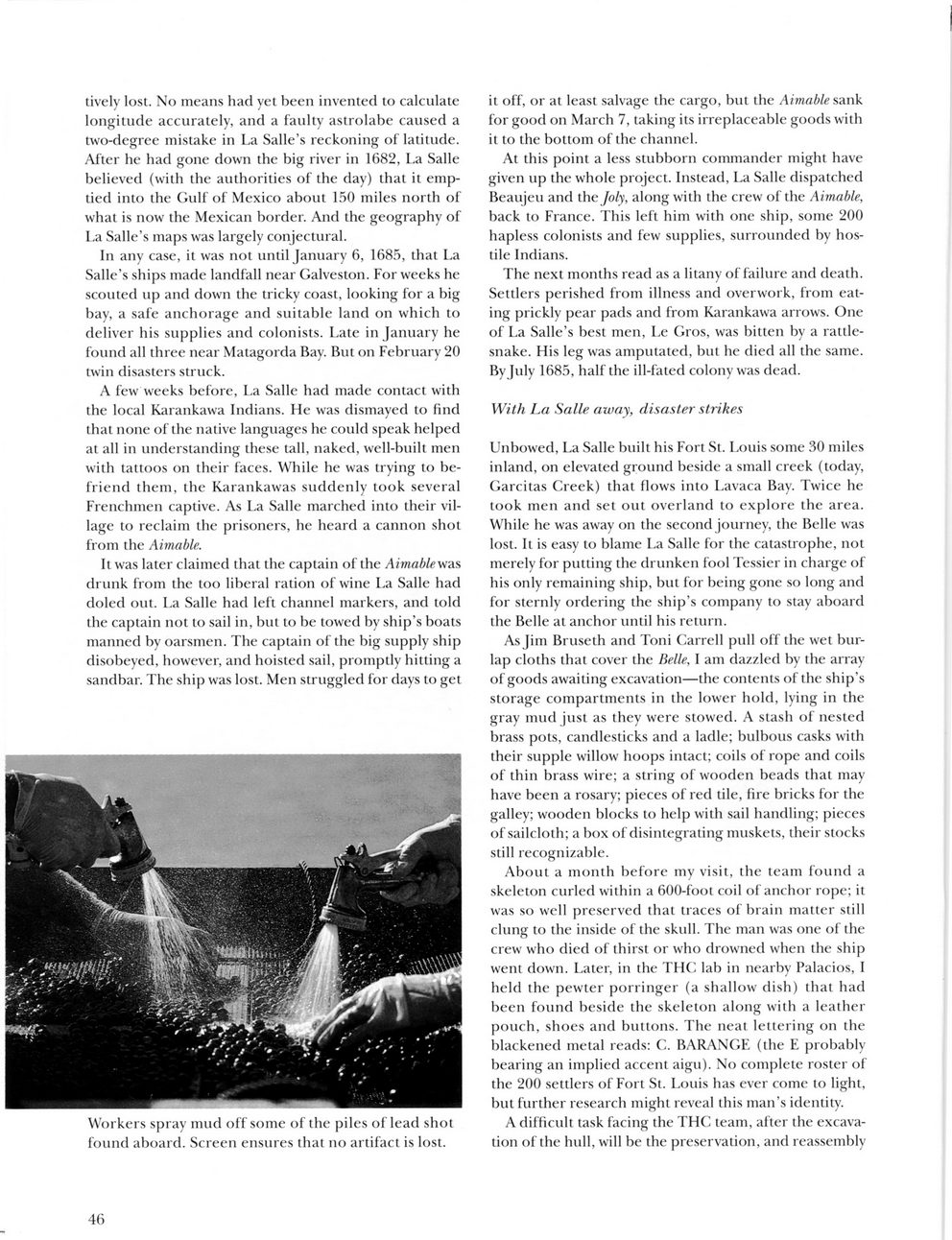This text was obtained via automated optical character recognition.
It has not been edited and may therefore contain several errors.
tively lost. No means had yet been invented to calculate longitude accurately, and a faulty astrolabe caused a two-degree mistake in La Salle?s reckoning of latitude. After he had gone down the big river in 1682, La Salle believed (with the authorities of the day) that it emptied into the Gulf of Mexico about 150 miles north of what is now the Mexican border. And the geography of La Salle?s maps was largely conjectural. In any case, it was not until January 6, 1685, that La Salle?s ships made landfall near Galveston. For weeks he scouted up and down the tricky coast, looking for a big bay, a safe anchorage and suitable land on which to deliver his supplies and colonists. Late in January he found all three near Matagorda Bay. But on February 20 twin disasters struck. A few weeks before, La Salle had made contact with the local Karankawa Indians. He was dismayed to find that none of the native languages he could speak helped at all in understanding these tall, naked, well-built men with tattoos on their faces. While he was trying to befriend them, the Karankawas suddenly took several Frenchmen captive. As La Salle marched into their village to reclaim the prisoners, he heard a cannon shot from the Aimable. It was later claimed that the captain of the Aimable was drunk from the too liberal ration of wine La Salle had doled out. La Salle had left channel markers, and told the captain not to sail in, but to be towed by ship?s boats manned by oarsmen. The captain of the big supply ship disobeyed, however, and hoisted sail, promptly hitting a sandbar. The ship was lost. Men struggled for days to get Workers spray mud off some of the piles of lead shot found aboard. Screen ensures that no artifact is lost. it off, or at least salvage the cargo, but the Aimable sank for good on March 7, taking its irreplaceable goods with it to the bottom of the channel. At this point a less stubborn commander might have given up the whole project. Instead, La Salle dispatched Beaujeu and the Joly, along with the crew of the Aimable, back to France. This left him with one ship, some 200 hapless colonists and few supplies, surrounded by hostile Indians. The next months read as a litany of failure and death. Settlers perished from illness and overwork, from eating prickly pear pads and from Karankawa arrows. One of La Salle?s best men, Le Gros, was bitten by a rattlesnake. His leg was amputated, but he died all the same. Byjuly 1685, half the ill-fated colony was dead. With La Salle away, disaster strikes Unbowed, La Salle built his Fort St. Louis some 30 miles inland, on elevated ground beside a small creek (today, Garcitas Creek) that flows into Lavaca Bay. Twice he took men and set out overland to explore the area. W'hile he was away on the second journey, the Belle was lost. It is easy to blame La Salle for the catastrophe, not merely for putting the drunken fool Tessier in charge of his only remaining ship, but for being gone so long and for sternly ordering the ship?s company to stay aboard the Belle at anchor until his return. As Jim Bruseth and Toni Carrell pull off the wet burlap cloths that cover the Belle, I am dazzled by the array of goods awaiting excavation?the contents of the ship?s storage compartments in the lower hold, lying in the gray mud just as they were stowed. A stash of nested brass pots, candlesticks and a ladle; bulbous casks with their supple willow hoops intact; coils of rope and coils of thin brass wire; a string of wooden beads that may have been a rosary; pieces of red tile, fire bricks for the galley; wooden blocks to help with sail handling; pieces of sailcloth; a box of disintegrating muskets, their stocks still recognizable. About a month before my visit, the team found a skeleton curled within a 600-foot coil of anchor rope; it was so well preserved that traces of brain matter still clung to the inside of the skull. The man was one of the crew who died of thirst or who drowned when the ship went down. Later, in the THC lab in nearby Palacios, I held the pewter porringer (a shallow dish) that had been found beside the skeleton along with a leather pouch, shoes and buttons. The neat lettering on the blackened metal reads: C. BARANGE (the E probably bearing an implied accent aigu). No complete roster of the 200 settlers of Fort St. Louis has ever come to light, but further research might reveal this man?s identity. A difficult task facing the THC team, after the excavation of the hull, will be the preservation, and reassembly

LaSalle 006